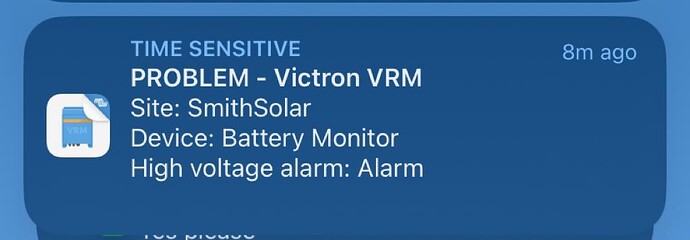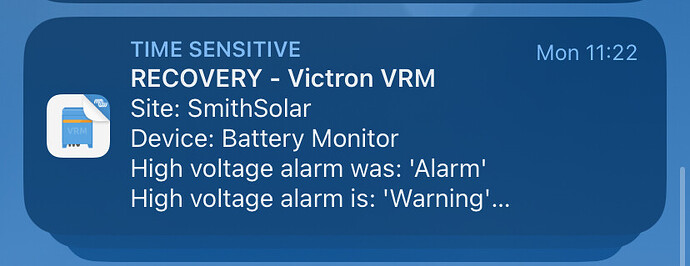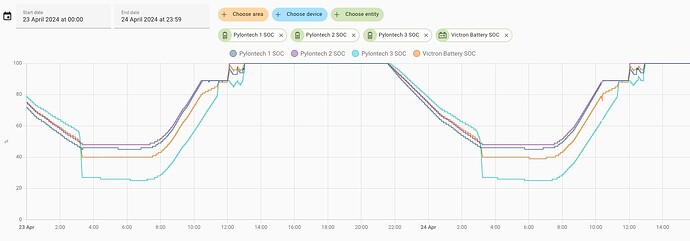Ohhh… that is quite normal. When you set the ESS mode to “keep batteries charged” it is equivalent (internally) to setting the setpoint to 32kW (assuming a single unit). It it bombs out when you set a 5kW setpoint… it will bomb out when you use KeepCharged. While this may have been an unintended mistake, it is not a sufficient excuse for a battery to go OV.
Thanks plonkster. The 5kW setpoint was one of the first controls I started applying on my Venus system from Home Assistant - stole the idea from another Saffer on the Victron community. I probably would do it different now…
That being said, the other automation change I did recently was to let Home Assistant set ESS to “Keep batteries charged” when the batteries reached 100%. I have automations in place to lift the min SOC as the batteries are charged throughout the day - typically to the closest multiple of 5 (e.g. if the batteries surpass 50%, the min SOC is set to 50%). That way, it keeps the batteries from being drained all the way with big loads and rather go back to the grid. Secondary, at certain points during the day (every 30 mins) I would lift the min SOC by 5% so that I force the batteries to charge from the grid and thus always have full batteries at the end of the day if the sun can’t do it. I then trigger a “Start discharge” later in the evening (Minc SOC at 25%).
This worked fined until around 95%, but I never set it to 100% (it just didn’t work as well, as was discussed elsewhere in the forum). So it would typically get to 100%, with the min SOC at 95%, and then the system would cycle down to 95, 96, 97 etc. and then charge back up to 100% again - depending on running the geyser, sunshine, loads etc. When I discovered the whole high voltage problem I decided to implement another automation to just set it to “keep batteries charged” when it reached 100% - I wonder if this made anything worse given the ESS’ “parallel matching to the grid” behavriour you mentioned?
Happy to run experiments, let me know.
Edit: apologies for the wall of text
Let me know what you find. I’m currently using a Raspberry Pi + a Pylontech console cable + a USB to serial cable to monitor the battery cell voltages. I am using a trial version of Solar Assistant to do the actual monitoring and send the results to MQTT where I can view it in Home Assistant.
BUT I do have a python script that I want to adjust to monitor the battery directly with and bypass Solar Assistant - that will also give me information of all 15 cells (and their temperatures).
OK, Pylontech support sent me the following after I sent them the logs for all three batteries (Does BatteryView download it for all the batteries at once?? No idea - so I plugged the cable in for each battery):
Hi,
I have sent you the latest firmware for the battery. Your battery version is too low and you can update the battery through BatteryView.
Your battery needs to be balanced.Please disconnect the battery pack and use a DC charger to charge each battery separately at 53.2V, 2A for 5-8 hours to balance the battery voltage.
Afterwards, you can recombine the batteries for use.Be careful not to make mistakes in the settings of your Victron inverter.
After completing the above process, if your battery still has issues, please contact us again.
And then instructions on how to connect a bench charger/power supply. Does anybody know where I can borrow / rent a bench power supply?
I don’t, but I made a plan BECAUSE it is the whole bank.
I took the MPII 5kva, disconnected the panels, even at night, just in case I miss tomorrow morning’s early sunrise, set the settings (charge volts, battery AH), and let it do the charging for me at night.
In your case, 3 evenings … or 3 x 5-8 hours consecutive … if it makes sense for you.
Disconnect/switch off the batts not charged.
Why not the panels? Read that utilities is a more stable charge source than panels over hours, for balancing.
Everyday now, between 10am and noon, I get 3 notifications of high voltage, each clearing after about 10mins. After noon, it shuts up, until 10am the next morning…
Any news on this? Any new people with the issue or successes at those with the problem?
Mine still gives a high-voltage alarm every 2 or 3 days. Still haven’t flashed firmware or tried charging the batteries from a bench power supply and haven’t spoken to Pylontech support since - turns out December wasn’t as long as I thought and the new year brought a bunch of crazy work related problems.
Same boat, still happens every now and then.
Was interesting that during December, when there was no load shedding, it stopped.
Spurious correlation?
I think they mean the following (I may be wrong), but this is what I gather / would tell my sparky to do (I don’t touch my batteries yet) based on that:
- Do the firmware update on the batteries.
- Set the Multi’s ESS to “Keep batteries charged”.
- Charge to 100% (although a slower initial charge at 53.2V might not be a bad idea.)
- Change the Multi’s DVCC to 53.2V & 2A as requested.
- Switch off the Multi, batteries, panels etc.
- Don’t feed any loads from the Multi (flip the changeover if you have one to have the loads in front of the Multi and don’t feed back past the Multi).
- Disconnect all but 1 battery.
- Start the battery & Multi up again.
- Leave it running for 5-8 hours to balance (and charge at 2A from the grid if needed).
- Repeat for the rest of the batteries.
- Reconnect the rest of the batteries and carry on as normal. (I’d actually keep everything as is for another 5-8 hours to just get a final balance between batteries if needed)
I agree that this will likely get the same results as a bench charger. That being said, will have to time all of this well enough around loud-shedding ![]()
What’s the latest view on this?
I’m still getting almost daily alerts
@plonkster @JacoDeJongh in your view is this something to be concerned about, or not?
How would you feel about an overvoltage protection mechanism that would detect this and basically shunt such energy into the grid? Potentially tripping a prepaid meter, but I see no other way.
The other thing to do, which is what the MultiRS does: Switch the device off if an overvoltage arises. Has happened to me once. There was a grid outage and the battery got very full, and then a PV-inverter wasn’t quite fast enough to back off. The Battery didn’t care about going slightly over 55.8V, the inverter however didn’t like it. This is probably a less popular option.
I haven’t really done anything yet about my Pylontech battery that probably has an issue - work work work ![]()
I am still getting daily alerts too, though.
Quick update. The culprit battery in my stack started showing additional issues: it’s own SOC drops much faster than the rest.
So it ended up shutting down one evening since I set my system to run down to 25% SOC every evening, but because this one fell so much faster it ended up below 8% SOC. Since it shut down the main battery ended up showing an error (and in VRM) as it lost comms with the broken battery.
Discussed it with Jaco and the battery was collected yesterday to see if we can claim warranty.
Each to their own, not all cut from the same cloth, not all interested in the same thing, but dang(!), I’m so glad I went DIY. It is my interest.
Cause the more I read stuff like this, years after installations, me prone to the really weird shiite going wrong, see that the issues are irrespective of brand, the more I realise I am so glad I have 4 spare cells!!! That I can swap a BMS whenever I want.
Man!
You need one of these.
In MY case, the 4 cells ARE the warranty!
Now I have a T-Shirt that states that!
The joke is, IF I hit <15 cells, split the bank into 12v cells and sell them on, recoup some of the costs, and start new. Or like getting 18 x >600ah cells one day … ![]()
Can you see individual battery SOCs in the VRM portal, or do you have to use modbus? (and, if modbus, what are the registers?)



